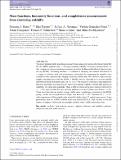Mass functions, luminosity functions, and completeness measurements from clustering redshifts
Abstract
This paper presents stellar mass functions and i-band luminosity functions for Sloan Digital Sky Survey (SDSS) galaxies with i < 21 using clustering redshifts. From these measurements, we also compute targeting completeness measurements for the Baryon Oscillation Spectroscopic Survey (BOSS). Clustering redshifts is a method of obtaining the redshift distribution of a sample of galaxies with only photometric information by measuring the angular cross-correlation with a spectroscopic sample in different redshift bins. We construct a spectroscopic sample containing data from the BOSS + eBOSS surveys, allowing us to recover redshift distributions from photometric data out to z ≃ 2.5. We produce k-corrected i-band luminosity functions and stellar mass functions by applying clustering redshifts to SDSS DR8 galaxies in small bins of colour and magnitude. There is little evolution in the mass function between 0.2 < z < 0.8, implying that the most massive galaxies form most of their mass before z = 0.8. These mass functions are used to produce stellar mass completeness estimates for the BOSS, giving a stellar mass completeness of 80 per cent above M⋆ > 1011.4 between 0.2 < z < 0.7, with completeness falling significantly at redshifts higher than 0.7, and at lower masses. Large photometric data sets will be available in the near future (DECaLS, DES, Euclid), so this and similar techniques will become increasingly useful in order to fully utilize these data.
Citation
Bates , D J , Tojeiro , R , Newman , J A , Gonzalez-Perez , V , Comparat , J , Schneider , D P , Lima , M & Streblyanska , A 2019 , ' Mass functions, luminosity functions, and completeness measurements from clustering redshifts ' , Monthly Notices of the Royal Astronomical Society , vol. 486 , no. 3 , pp. 3059-3077 . https://doi.org/10.1093/mnras/stz997
Publication
Monthly Notices of the Royal Astronomical Society
Status
Peer reviewed
ISSN
0035-8711Type
Journal article
Rights
© 2019, Published by Oxford University Press on behalf of the Royal Astronomical Society. This work has been made available online in accordance with the publisher's policies. This is the final published version of the work, which was originally published at https://doi.org/10.1093/mnras/stz997
Collections
Items in the St Andrews Research Repository are protected by copyright, with all rights reserved, unless otherwise indicated.

